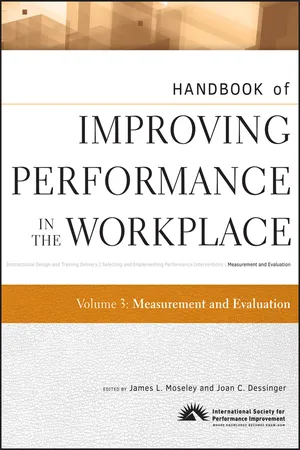Business
Measuring Success in Business
Measuring success in business involves evaluating the achievement of specific goals and objectives, such as financial targets, customer satisfaction, and market share. Key performance indicators (KPIs) are used to quantify and track progress towards these goals, providing a basis for informed decision-making and strategic planning. Effective measurement of success enables businesses to identify areas for improvement and optimize their performance.
Written by Perlego with AI-assistance
Related key terms
6 Key excerpts on "Measuring Success in Business"
- eBook - ePub
- (Author)
- 2009(Publication Date)
- Harvard Business Review Press(Publisher)
In much the same way, organizations want—and need—to track the changes in their overall performance. And the divisions, units, teams, and individuals within them engage in similar scorekeeping. Let’s take a closer look at this desire to measure business performance.Why appraise business performance?
Organizations measure their performance for numerous reasons. Here are just a few:- Improvement: By tracking performance, companies can spot—and promptly address—problems such as declining customer loyalty, flattening profits, or defections of talented employees.
- Planning and forecasting: Performance measurement serves as a progress check, enabling organizations to determine whether they’re meeting their goals and whether they need to revise their budgets and forecasts.
- Competition: When companies compare their performance against their rivals’ and against industry benchmarks, they can identify weak areas and address them to sharpen their competitive edge.
- Reward: By knowing how much employees have excelled in achieving goals, managers can distribute performance-based incentives and rewards fairly to their direct reports.
- Regulatory and standards compliance: Many companies measure performance in order to comply with government regulations (such as antipollution laws) or international standards (for instance, ISO 9000).
What is performance measurement?
In its simplest terms, measuring performance means assessing business results to: (1) determine the effectiveness of a company’s strategy and the efficiency of its operating processes, and (2) make changes to address shortfalls and other problems.Companies take stock of their performance using different methods and criteria. However, in many organizations, performance measurement entails examining the results generated by key business activities, using specific performance metrics (also known as measures). For each business activity, there are numerous possible metrics. Table 1 - eBook - ePub
Management Accounting
An Integrative Approach
- Carol J. McNair-Connolly, Kenneth A. Merchant(Authors)
- 2020(Publication Date)
- Wiley(Publisher)
a simple and accurate gauge of an employee’s or unit’s progress or results against a CSF. KPIs make the CSFs actionable and understandable. They allow the firm, and its managers, to monitor and communicate performance against its goals and desired results on an ongoing basis. Timeliness, quality, and cost are three common KPIs used by companies to track the firm’s and/or a process’s progress against strategic objectives.When we put a specific definition around a KPI, it becomes ameasure, a KPI that has a specific definition, unit, or quantity. For instance, we might define timeliness for Easy Air in terms of the percentage of flights that depart the gate at their scheduled time. Another definition for timeliness might be the number of flights that arrive at their destination at the scheduled time. The former would measure performance at the beginning of thevalue-creating process, the sequence of activities and outcomes that are focused on meeting or exceeding customer expectations; it is the basis for competitive positioning and success. The latter measure would measure performance at the end of the value-creating process. Clearly, Easy Air would choose the measure that most closely corresponds to the customers’ definition of a successful flight. It is quite likely arriving on time will matter more to the customers who are taking several flights in a day because they may need to make tight connections.In a related manner, Easy Air could measure its quality in terms of the number of lost or misplaced bags, while cost could be captured in terms of the cost per passenger flown on a specific flight. In other words, we have to measure many different aspects of the organization to ensure that its strategic objectives are met. We cannot focus on just one dimension, such as customer service or on-time performance. Why? If we only measure one dimension, everyone’s attention will be directed solely on that dimension of performance to the exclusion of other, equally important, actions and results. - eBook - ePub
Executive Engagement Strategies
How to Have Conversations and Develop Relationships that Build B2B Business
- Bev Burgess(Author)
- 2020(Publication Date)
- Kogan Page(Publisher)
All objectives you set should be SMART: specific, measurable, achievable (not pie in the sky), realistic (not too easy) and time bound. The best way to think about the objectives for your programme is in three categories: building your organization’s reputation, strengthening its relationships with customers and influencers and growing revenues. Once you’ve defined what you want to achieve, in specific and not general terms, and with a clear timescale in mind, it’s time to set some measures of success so that you know you’re on track to deliver against your objectives.Measuring outcomes
There is a balance to be had between tracking performance metrics that help you continually refine what you’re doing in your programme and tracking outcomes that your business leaders will care about. Traditionally, marketers running programmes such as executive engagement have done too much of the former and not enough of the latter.The knock-on effect of this focus on activities is that the marketing function is seen as a support function, not delivering strategic value to the business.Figure 10.1 shows a continuum of metrics you can measure, ranging from activity based (counting effort and tracking costs), through to more output based (counting results and measuring efficiency), to outcome based (reporting outcomes delivered and even anticipating and forecasting future outcomes).SOURCE ‘Measuring What Matters to Improve Marketing Performance’, ITSMA, August 2019Figure 10.1 Moving from activity to outcome-based metricsFigure 10.1 details The last three blocks are shaded with a caption that reads, ‘Marketing is a strategic function’. The blocks along with its features are represented by a nested list below. - eBook - ePub
Performance Management Systems
An Experiential Approach
- Arup Varma, Pawan Budhwar(Authors)
- 2019(Publication Date)
- SAGE Publications Ltd(Publisher)
In this chapter, we’ll discuss important considerations for defining and measuring performance, including how to define performance, the purpose of measurement, the content of measurement, measurement techniques, and measuring performance across levels. Defining Performance Before you can measure performance, you must define what performance is for your company and its employees. This chapter will focus on for-profit companies primarily, but non-profit firms must also define performance in accordance with whatever their mission is. Traditionally in for-profit firms, firm performance has generally been understood as financial performance, but more recent work has broadened this concept somewhat (see DeNisi & Smith, 2014). Even in a traditional firm, companies may include measures beyond financial performance, like customer service or organizational learning (Wildman et al., 2011), market share, quality, or new product launches (Venkatraman & Ramanujam, 1986), and even organizational awards (e.g., Forbes ’ World’s Most Valuable Brands or Fortune ’s World’s Most Admired Companies). Table 5.1 illustrates key dimensions of performance beyond pure financial outcomes that can be considered at different levels in the organization. In recent years, some for-profit organizations have even begun broadening their scope to consider ‘triple-bottom line’ (Elkington, 1994) performance, which encompasses financial, environmental, and social performance; to incorporate a social or environmental purpose central to the organization’s mission; or to emphasize corporate social responsibility. These companies would consider the organization’s environmental impact (perhaps including carbon emissions, recycling and reuse in manufacturing, etc.), its contribution to its social mission (such as how many shoes TOMS has been able to donate through its sales), or even the wage and satisfaction rates of its employees as part of overall organizational performance - eBook - ePub
The Story of Industrial Engineering
The Rise from Shop-Floor Management to Modern Digital Engineering
- Adedeji B. Badiru(Author)
- 2018(Publication Date)
- CRC Press(Publisher)
Employees, supervisors, and managers should be encouraged to establish and maintain indicators that they can use as yardsticks to understand and improve the performance of their units, regardless of whether these indicators are needed for reporting upline. Simply measuring a key performance indicator and making it promptly visible for those who deliver this performance can lead to improvement with little additional action from management. This assumes that those who deliver this performance know the desired direction for improvement on this indicator and have the resources and discretion to take actions for improvement. It is leadership’s job to make sure the people in the organization have the knowledge, resources, discretion, and direction to use performance information to make improvements.PlanningMeasuring for the purpose of planning has at least two functions: (1) increasing understanding of current capabilities and the setting of realistic targets (i.e., goals) for future performance; and (2) monitoring progress toward meeting existing plans. One could argue that these simply represent planning-centric versions of measuring for improvement and then measuring for control. The role of measuring performance as part of a planning effort is important enough to warrant a separate discussion.Nearly all strategic management or strategic planning efforts begin with understanding the organization and its environment. This effort is referred to as internal and external strategic analysis (Thompson and Strickland, 2003), organizational systems analysis (Sink and Tuttle, 1989), or, in plain words, “preparing to plan.” A key part of internal analysis is understanding current performance levels, including the current value of key performance indicators and their recent trends. This provides the baseline for future performance evaluations of the effectiveness of the planned strategy and its deployment. Also, the choice of key performance indicators tells the organization what is important and is a specific form of direction often more carefully followed than narrative statements of goals and vision. Understanding current performance and its relation to current processes and resources provides managers with a realistic view of what is possible without having to make substantial changes to the system. Thus, setting intelligent targets for future performance requires an understanding of how implementation of the plan will change processes and resources to enable achievement of these targets. A key part of the external analysis is obtaining relevant comparisons so that the competitiveness of current performance levels and future performance targets can be evaluated. To answer the question of how good a particular performance level is, one must ask “compared to what?” Current competitor performance provides an answer to this question, but it must be assumed that competitors are also planning for improved performance. Setting future performance targets must take this moving competitive benchmark into account. Even the projected performance of your best current competitor may be inadequate as a future performance target to beat. The strategic management literature is full of examples of corporations that did not see their new competition coming and were blindsided by new competitors playing by different rules with substitutes for the bread-and-butter products of these corporations (see Hamel, 2002; Hamel and Prahalad, 1996). As Drucker (1998) has pointed out, some of the most important information managers need comes from outside their organizations and even outside their industries. A challenge for performance measurement is to provide not only internal but also external performance information that provides competitive intelligence for making strategic decisions. - James L. Moseley, Joan C. Dessinger(Authors)
- 2009(Publication Date)
- Pfeiffer(Publisher)
We use many terms in the field of performance measurement and evaluation, some of which have been defined in detail and with great technical sophistication elsewhere in this volume. For purposes of this chapter, here is a short list of concepts, defined with the intention of eliminating confusion, and appealing as much as possible to plain English explanations.Measurement
Measurement is the process by which we identify the dimension, quantity, or capacity [of a thing] (American Heritage Dictionary, 2006). In the field of performance improvement, this term refers to the identification of what to count (business results, work output, and/or behavior); selection of relevant quantitative units of measurement (such as simple counts, kilograms, meters, liters, or other measures); and collection of data expressed in those units. For example, we might identify a successful business proposal as a countable work output and include criteria that define a “successful” proposal. We can then count successful proposals over successive time intervals prior to intervention to determine “baseline” levels of productivity. We might additionally count unsuccessful proposals and use the “success ratio” of successful to unsuccessful ones as a secondary measure. Once we have decided on an intervention to improve business proposal productivity and quality, we can continue to count during successive time intervals to monitor whether or not the quantity of proposals and/or the ratio of successful to unsuccessful proposals is improving. This is not very different from keeping score in a sporting event, after first defining what constitutes a score, an error, a foul, and so on.Evaluation
Evaluation is a process by which we evaluate or ascertain the value or worth of [a thing]. (American Heritage Dictionary, 2006). In performance improvement, we use measurement, plus some sort of evaluation design, to determine the impact and worth of an intervention. If, for example, measurement shows that the proportion of successful proposals as well as the total number of proposals completed per month accelerate after an intervention, and if we also measure the dollar value of successful proposals (and perhaps the average unit cost for submitting proposals), then we can determine (that is, evaluate
Learn about this page
Index pages curate the most relevant extracts from our library of academic textbooks. They’ve been created using an in-house natural language model (NLM), each adding context and meaning to key research topics.





